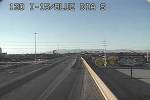‘Platooning’ tractor-trailer convoys destined for an interstate near you

In the months ahead, you might be seeing tractor-trailer rigs on Nevada’s interstate highways traveling within 20 feet of each other at top speed.
It’s almost as if they’re connected. And in some respects, they are.
Menlo Park, Calif.-based Peloton Technology recently demonstrated its vehicle-to-vehicle communications and driver assistance technology to three Nevada transportation agencies, the Nevada Department of Transportation, the Nevada Department of Public Safety and the Nevada Department of Motor Vehicles.
The demonstration was on a section of Interstate 80 east of Reno. I-80 is an important artery for freight from Northern California to Utah and it’s perfect for “platooning.” That’s what they call the process of establishing a communications link between one big rig and another that enables both of them to cut wind resistance and operate more efficiently. According to the manufacturer of the system, it’s also safer.
“We talk about it as synchronizing the actions of two trucks,” said Josh Switkes, CEO of Peloton.
The brakes and accelerators of the trucks work together and the actions of the rear truck occur instantly when applied by the lead driver. It’s cruise control on steroids.
“Humans typically take one or two seconds to react to something while driving, but with this system, it takes hundredths of a second,” Switkes said. “When you’re riding in the truck, it seems simultaneous.”
Switkes said platooning improves safety because it prevents the most common truck-driving accidents.
Reducing aerodynamic drag is what saves fuel for both the lead and the trailing truck. Switkes said the lead truck saves about 4.5 percent in fuel costs while the trailing truck benefits by 10 percent.
So it’s safety, conservation and environmental benefits rolled into one system.
In the demonstration, Peloton ran the vehicles 40 feet apart, but in a pilot program, distances are ranging from 20 to 75 feet.
No laws have to be changed to use the technology.
“Nevada has been a leader in transportation technology in general, which is why we decided to work with the state,” Switkes said.
Peloton hopes to have a visual indicator in place to inform the Nevada Highway Patrol that platooning is occurring so that officers don’t pull over a driver for tailgating. Switkes said he has talked to executives of dozens of freight companies who said most companies would be willing to platoon with competitors to share the benefits of a system.
Switkes said someday, there might be applications for passenger cars traveling cross-country.
The company isn’t disclosing the price of the system, but says it will pay for itself in savings in 6½ months.
SIENA GOLF CARTS
It didn’t take long for a representative of the Siena Community Association to get ahold of me after I shared recently how difficult it was to get a straight answer about whether golf carts are allowed on the community’s streets.
The short answer is they are.
“According to Siena’s rules and regulations, applicable and available to every resident living in Siena, ‘Individuals operating golf carts on Siena’s private streets shall have a valid driver’s license and must follow all rules of the road as if they were operating an automobile and shall be driven on the far right side of the roadway,’ ” Mike Cutler, president of the Siena Community Association’s board of directors, said in an email.
Cutler said in the 15 years that Siena has existed, there has never been a golf cart traffic accident in the community or a complaint about golf carts on the streets fielded by the association.
So that settles things. Golf carts are allowed at Siena, but they should be kept off the streets outside the community.
AIR CANADA IN PRE-CHECK
A new airline has become a Transportation Security Administration Pre-Check partner — and it’s the first international operator to join.
Air Canada, which has an average five daily round trips between Las Vegas and four hubs at Toronto; Montreal; Calgary, Alberta; and Vancouver, British Columbia, uses McCarran’s Terminal 3.
Passengers on Air Canada’s Rouge discount subsidiary also can use Pre-Check for its D gate departures.
It’s the 10th airline with flights at McCarran International Airport to become a part of the program.
Pre-Check is a trusted traveler program for frequent fliers.
Eligible participants can use special security lines at which they don’t have to take off their shoes, belts and jackets and don’t have to display their laptop computers or quart-sized plastic toiletry bags.
In addition to passengers who pay $85 to enroll in Pre-Check for five years, the TSA randomly selects flights and their passengers to use the special lines.
Canadians can use the Pre-Check lines by enrolling in that country’s NEXUS program.
Send questions and comments to roadwarrior@reviewjournal.com. Please include your phone number. Follow @RJroadwarrior on Twitter.


















